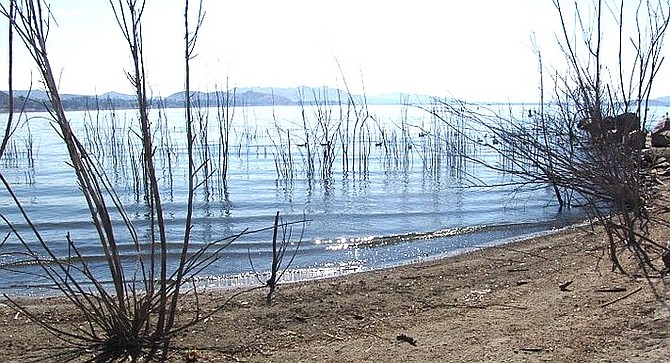 Facebook
Facebook
 X
X
 Instagram
Instagram
 TikTok
TikTok
 Youtube
Youtube

About twenty miles north of the San Diego-Riverside county line, and situated at the lowest point within the San Jacinto River watershed, lies the largest natural freshwater lake in Southern California — Lake Elsinore. At an average depth of 27 feet, the lake is not unlike its cousin, the not-so-natural Salton Sea; algae blooms and rich nutrients have caused die-offs of fish, and pungent scents rise from its murky-green water. There the comparison ends, especially after drought cycles; where the Salton Sea has been in continual die-off, Lake Elsinore revives and thrives; where the Salton Sea’s communities have faded, Lake Elsinore, the city, has bloomed.
The difference might be in the fishing. Lake Elsinore has a habit of coming back strong after die-offs during drought years, especially the largemouth bass and crappie fishery. Also blue catfish, channel catfish, striped bass/ white bass hybrids known as “wipers,” bluegill, redear sunfish, and carp, live in the relatively shallow lake.
This last year and after six years of lake-killing drought, the lake received eight feet of added depth, providing lots of brushy structure for baitfish, including threadfin shad, to hide in, and predator fish to hunt, and thus for anglers to target.
In the springtime, when the winter rains have been above average, the shoreline among the submerged vegetation is where the action is. For all species in the lake, bobber- rigged baits or mini-jigs work well in the shallows at two to four feet deep, while crankbaits and plastic worms can get results alongside structure in four to twelve feet of water.
Lake Elsinore’s Dream Extreme Fishing Derby will be this coming weekend. The two-day event hosted by the Lake Elsinore Casino draws anglers of all levels.


About twenty miles north of the San Diego-Riverside county line, and situated at the lowest point within the San Jacinto River watershed, lies the largest natural freshwater lake in Southern California — Lake Elsinore. At an average depth of 27 feet, the lake is not unlike its cousin, the not-so-natural Salton Sea; algae blooms and rich nutrients have caused die-offs of fish, and pungent scents rise from its murky-green water. There the comparison ends, especially after drought cycles; where the Salton Sea has been in continual die-off, Lake Elsinore revives and thrives; where the Salton Sea’s communities have faded, Lake Elsinore, the city, has bloomed.
The difference might be in the fishing. Lake Elsinore has a habit of coming back strong after die-offs during drought years, especially the largemouth bass and crappie fishery. Also blue catfish, channel catfish, striped bass/ white bass hybrids known as “wipers,” bluegill, redear sunfish, and carp, live in the relatively shallow lake.
This last year and after six years of lake-killing drought, the lake received eight feet of added depth, providing lots of brushy structure for baitfish, including threadfin shad, to hide in, and predator fish to hunt, and thus for anglers to target.
In the springtime, when the winter rains have been above average, the shoreline among the submerged vegetation is where the action is. For all species in the lake, bobber- rigged baits or mini-jigs work well in the shallows at two to four feet deep, while crankbaits and plastic worms can get results alongside structure in four to twelve feet of water.
Lake Elsinore’s Dream Extreme Fishing Derby will be this coming weekend. The two-day event hosted by the Lake Elsinore Casino draws anglers of all levels.
Comments